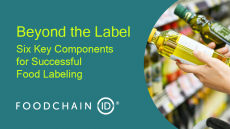Baby food companies now facing at least 43 lawsuits over heavy metals

Since the report alleging "dangerously high" levels of lead, mercury, cadmium and arsenic in selected baby food products was published on February 4, all of the companies named in it - Gerber, Beech Nut Nutrition, Campbell Soup (Plum Organics), Nurture Inc (Happy Family Organics), Hain Celestial (Earth’s Best), Sprout Foods Inc, and Walmart - have been hit with lawsuits in multiple districts.
The FDA, meanwhile - which has set action levels for some heavy metals in bottled water, juice, candy, and infant rice cereals, but not all baby foods - is now accelerating plans to set action levels for key contaminants in “foods specifically manufactured for babies and toddlers, and also at foods that are commonly eaten by babies and toddlers."
The baby food brands named in the report noted that many foods contain trace amounts of heavy metals, which are found in soil and water, whether they are prepared at home or sold as packaged food, and that this is an industry-wide challenge that many of them have been working with regulators and nonprofits to address in the absence of federally mandated thresholds/action levels.
Plaintiff's attorneys, meanwhile, argue that "these products are being marketed to young Millennials with young children" who would not expect "dangerous neurotoxins in baby food marketed for the first year of life.”
'Common factual allegations and involving overlapping claims and legal issues'
In a motion for transfer filed with the US Judicial Panel on Multidistrict Legislation, plaintiffs in one of the cases (Albano et al v Hain Celestial Group) argue that it makes sense for all of the related lawsuits to be transferred to Judge Joanna Seybert in the Eastern District of New York, given that three of the defendants are located in New York (Hain Celestial, Beech-Nut, and Nurture Inc), and 13 of the lawsuits are pending in the Eastern District.
The motion involves at least 43 actions—including 38 proposed class actions— pending in 12 different federal district courts “asserting common factual allegations and involving overlapping claims and legal issues,” argue the Albano plaintiffs, who predict more lawsuits will follow.
“Based on the numerous common questions of fact and law involved, the compelling need to establish uniform and consistent standards in conducting pretrial discovery and motion practice, and because the most logical and convenient location for these proceedings is the Eastern District of New York, Albano Plaintiffs respectfully request coordinated proceedings there before District Judge Joanna Seybert.”
'Serious risk of conflicting rulings' if cases not consolidated
If the cases proceed separately or are consolidated within key districts, “at least 12 different federal courts will rule on the common factual and legal issues in these cases,” claim the Albano plaintiffs.
“All of these issues create serious risk of conflicting rulings that results in confusion and potentially inconsistent obligations for Defendants. When common questions of fact exist like with these cases, the Judicial Panel on Multidistrict Legislation should consolidate and transfer actions to prevent duplication of discovery and eliminate the possibility of inconsistent pretrial rulings.”
The allegations in the lawsuits vary, but the complaints seen by FoodNavigator-USA claim that the defendants’ baby foods contained harmful heavy metals including lead, cadmium, mercury and arsenic; featured false and misleading labeling; and failed to disclose material facts. They also assert economic injuries and seek damages.
The defendants won't comment on pending litigation, but say they plan to defend the lawsuits "vigorously."
- Click HERE for an analysis of how some of the claims made in the lawsuits might be addressed.
A report released Feb 4 by the Subcommittee on Economic and Consumer Policy in the House of Representatives calls for:
- Mandatory testing for toxic heavy metals in finished products, not just ingredients
- Labeling of levels of toxic heavy metals on pack
- Maximum levels of toxic heavy metals permitted in baby foods to be set by the FDA
Picture: Gettyimages-SeventyFour
Under pressure to act in the wake of the recent congressional report into heavy metals in baby food, the FDA recently said it would issue "guidance to identify action levels for contaminants in key foods," as lawsuits against baby food brands pile up.
"We are looking at foods specifically manufactured for babies and toddlers (i.e. baby food) and also at foods that are commonly eaten by babies and toddlers that may also be a source of exposure to toxic elements in the environment. Our action levels for foods will be health-protective and may take into consideration a number of factors, such as the levels of toxic elements found in these foods, through FDA sampling and other data, expected exposure based on eating patterns, and the feasibility of meeting identified action levels."
The move follows a letter from New York Attorney General Letitia James urging the FDA to follow recommendations in the Feb 4 congressional subcommittee report and set limits for toxic metals across all baby foods.
To date, the FDA has set maximum allowable levels in bottled water at 10 ppb inorganic arsenic, 5 ppb lead, and 5 ppb cadmium, while the EPA has capped the allowable level of mercury in drinking water at 2 ppb.
The FDA has also set limits on lead in juice [50ppb], and candy [0.1ppm], and has set a 100ppb limit on inorganic arsenic in infant rice cereals. and proposed a 10ppb limit on inorganic arsenic in apple juice.
There are as yet no federally mandated upper limits for lead, mercury and cadmium in baby foods, however.
Parents alarmed by headlines about 'toxins' in baby food are right to be concerned, but should think before throwing out their packaged infant foods, said Bob Durkin, formerly deputy director at the office of dietary supplement programs at the FDA, and now of counsel at Arnall Golden Gregory.
"It would likely be a mistake for parents to suddenly begin to feed their children other food that may be dangerous and present other types of hazards," he told FoodNavigator-USA. "For example, homemade baby food could end up with a similar level of heavy metals, or worse, because parents would likely be making it from a lot of the same ingredients in the commercial versions."
Homemade baby food can also introduce microbiological risks if you are not careful, he added: "I would advise parents to let more details come out about the situation before they make any drastic changes."
























